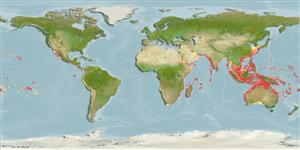Environment: milieu / climate zone / profondeur / distribution range
Écologie
marin récifal; profondeur 1 - 100 m (Ref. 48635). Tropical; 35°N - 37°S
Indo-Pacific: Red Sea and East Africa to the Hawaiian, Marquesan and Tuamoto islands, north to southern Japan and the Ogasawara Islands, south to Australia and New Zealand.
Taille / Poids / Âge
Maturité: Lm ? range ? - ? cm
Max length : 40.0 cm TL mâle / non sexé; (Ref. 3392); common length : 20.0 cm TL mâle / non sexé; (Ref. 3392); poids max. publié: 383.00 g (Ref. 132231)
Épines dorsales (Total) : 7; Rayons mous dorsaux (Total) : 9; Épines anales: 0; Rayons mous anaux: 6 - 7. Heavily armored box-like body and wing-like pectoral fins (Ref. 37816).
Body shape (shape guide): elongated; Cross section: circular.
Inhabit coastal waters with sandy substrates (Ref. 1602, 48635); a shallow-living species, benthic in adults; only species found in oceanic islands (Ref. 27821). Solitary, well-camouflaged and slow-moving (Ref. 37816, 48635). Feed on crustaceans, clams, and small fish. May be caught using ring nets (Ref. 5213).
Life cycle and mating behavior
Maturité | Reproduction | Frai | Œufs | Fécondité | Larves
Paxton, J.R., D.F. Hoese, G.R. Allen and J.E. Hanley, 1989. Pisces. Petromyzontidae to Carangidae. Zoological Catalogue of Australia, Vol. 7. Australian Government Publishing Service, Canberra, 665 p. (Ref. 7300)
Statut dans la liste rouge de l'IUCN (Ref. 130435: Version 2024-2)
Menace pour l'homme
Harmless
Utilisations par l'homme
Pêcheries: intérêt commercial mineur; Aquarium: Commercial
Outils
Articles particuliers
Télécharger en XML
Sources Internet
Estimates based on models
Preferred temperature (Réf.
123201): 23.3 - 29, mean 27.8 °C (based on 1738 cells).
Phylogenetic diversity index (Réf.
82804): PD
50 = 0.5235 [Uniqueness, from 0.5 = low to 2.0 = high].
Bayesian length-weight: a=0.00550 (0.00229 - 0.01319), b=3.09 (2.88 - 3.30), in cm total length, based on LWR estimates for this (Sub)family-body shape (Ref.
93245).
Niveau trophique (Réf.
69278): 3.7 ±0.55 se; based on food items.
Generation time: 0.7 ( na - na) years. Estimated as median ln(3)/K based on 1
growth studies.
Résilience (Réf.
120179): Haut, temps minimum de doublement de population inférieur à 15 mois (Preliminary K or Fecundity.).
Fishing Vulnerability (Ref.
59153): Low vulnerability (18 of 100).
🛈
Nutrients (Ref.
124155): Calcium = 86.6 [38.6, 195.6] mg/100g; Iron = 0.876 [0.407, 2.444] mg/100g; Protein = 18 [16, 20] %; Omega3 = 0.142 [0.060, 0.444] g/100g; Selenium = 70.6 [30.3, 174.1] μg/100g; VitaminA = 29.6 [9.4, 93.3] μg/100g; Zinc = 1.27 [0.80, 1.93] mg/100g (wet weight);
